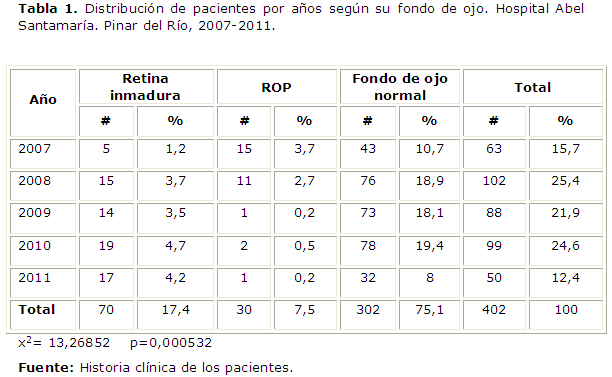Risk factors and behavior of retinopathy of prematurity
Keywords:
Retinopathy of prematurity, Neonatology, Risk factors.Abstract
Introduction: retinopathy of prematurity constitutes an important cause of morbidity worldwide, leading to blindness if it is not diagnosed and treated appropriately.Objective: to assess the behavior of retinopathy of prematurity in preterm newborn infants at "Abel Santamaria Cuadrado" University Hospital in Neonatology Service, Pinar del Rio province, from January 2007 to December 2011.
Method: an observational, cross-sectional and retrospective study that included 402 patients younger than 35 weeks of pregnancy and/or under 1700 grams, or those over this gestational age and weight, but presenting risks factors to develop the disease. Gestational age, weight at birth, degree of retinopathy and associated risk factors were the variables used. The collection of data were taken from the individual clinical history, and processed by means of Microstad and Epi-info.
Results: the frequency of retinopathy was 7.5%, degree I prevailed in zones 1,2 or 3, and was present in 6.7% and 6.8% of the patients who were born with less than 34 weeks and 7.8% with less than 1700 grams; 100% of the cases underwent supplementary oxygenation, 505 presented respiratory distress and 23.3% suffered from sepsis.
Conclusions: the incidence of retinopathy of prematurity diminished in Pinar del Rio province, degree I was the most frequent, those who were born with less than 34 weeks and 1700 grams were the most affected, the associated risk factors were: oxygen treatment, respiratory distress and neonatal sepsis.
Downloads
References
1. Castro Pérez PD, Rodríguez Masó S, Rojas RondónI I, Padilla González C, Fernández Cherkásova L. Epidemiología y rehabilitación de la retinopatía de la prematuridad en el servicio de baja visión. Rev Cubana Oftalmol [Internet]. 2010 [citado 12 Dic 2012]; 23(1): [aprox. 12p.]. Disponible en: http://scielo.sld.cu/scielo.php?script=sci_arttext&pid=S0864-21762010000100015&lng=es&nrm=iso&tlng=es
2. Fernández Ragi RM, Toledo González Y, García Fernández Y, Rodríguez Rivero M, García Díaz O. Incidencia de la retinopatía de la prematuridad en el bajo peso. Rev Cubana Oftalmol [Internet]. 2010 [citado 12 Dic 2012]; 23(Sup 1): [aprox. 9p.]. Disponible en: http://scielo.sld.cu/scielo.php?script=sci_arttext&pid=S0864-21762010000300013&lng=es&nrm=iso&tlng=es
3. Andújar Coba P, Mier Armas M, Coba MJ, Pérez Torga JE. Factores predisponentes de la retinopatía de la prematuridad en el municipio Playa. Rev Cubana Oftalmol [Internet]. 2009 [citado 12 Dic 2012]; 22(2): [aprox. 8p.]. Disponible en: http://scielo.sld.cu/scielo.php?script=sci_arttext&pid=S0864-21762009000200012&lng=es&nrm=iso&tlng=es
4. Torres Leyva M. Retinopatía de la Prematuridad en Ciudad de la Habana: factores que influyen en su desarrollo. [Tesis doctoral]. La Habana: Instituto Superior de Ciencias Médicas de La Habana: Facultad Calixto García; 2009. http://tesis.repo.sld.cu/360/1/MidialaTorres.pdf
5. Toledo González Y, Soto García M, Mier Armas M, Chiang Rodríguez C, Santana Alas ER. Comportamiento de la retinopatía de la prematuridad en el Hospital General "Iván Portuondo"en el año 2009. Rev Cubana Oftalmol [Internet]. 2010 [citado 12 Dic 2012]; 23(supl 2): [aprox. 10p.]. Disponible en: http://scielo.sld.cu/scielo.php?script=sci_arttext&pid=S0864-21762010000400013&lng=es&nrm=iso&tlng=es
6. Lloyd J, Askie L, Smith J, Tarnow-Mordi W. Oxígeno suplementario para el tratamiento de la retinopatía preumbral del prematuro. Base de Datos Cochrane de Revisiones Sistemáticas. [Internet]. 2007 [citado 8 Nov 2012]; 4: [aprox. 3 p]. Disponible en: http://apps.who.int/rhl/newborn/reviews/cd003482/es/
7. Castro Pérez PD, Rodríguez Masó S, Pons Castro L, Arias Diaz A, Estévez Miranda Y. Frecuencia de estrabismo en pacientes con retinopatía de la prematuridad. Rev Cubana Oftalmol [Internet]. 2010 [citado 12 Dic 2012]; 23(2): [aprox. 10p.]. Disponible en: http://scielo.sld.cu/scielo.php?script=sci_arttext&pid=S0864-21762010000200012&lng=es&nrm=iso&tlng=es
8. Gilbert C, Muhit M. Twenty years of childhood blindness: what have we learnt?. Community Eye Health [Internet]. 2008 [citado 8 Nov 2012]; 21(67): [aprox. 2p.]. Disponible en: http://www.ncbi.nlm.nih.gov/pmc/articles/PMC2580065/
9. Torres Leyva M, Expósito Fernández Y. Aspectos éticos en el diagnóstico y tratamiento de la retinopatía de la prematuridad. Rev Cubana Oftalmol [Internet]. 2010 [citado 8 Nov 2012]; 23(Supl. 1): [aprox. 8 p.]. Disponible en: http://scielo.sld.cu/scielo.php?script=sci_arttext&pid=S0864-21762010000300016&lng=es
10. Fernández Ragi RM, Toledo González Y, García Fernández Y, Rodríguez Rivero M, García Díaz O. Retinopatía de la prematuridad en el neonato con peso menor de 1 500 g. Rev Cubana Pediatr[Internet].2010 [citado 10 Nov 2012]; v.82 n.1 Ciudad de la Habana . Disponible en: http://scielo.sld.cu/scielo.php?script=sci_arttext&pid=S0034-75312010000100003

Published
How to Cite
Issue
Section
License
Authors who have publications with this journal agree to the following terms: Authors will retain their copyrights and grant the journal the right of first publication of their work, which will be publication of their work, which will be simultaneously subject to the Creative Commons Attribution License (CC-BY-NC 4.0) that allows third parties to share the work as long as its author and first publication in this journal are indicated.
Authors may adopt other non-exclusive license agreements for distribution of the published version of the work (e.g.: deposit it in an institutional telematic archive or publish it in a volume). Likewise, and according to the recommendations of the Medical Sciences Editorial (ECIMED), authors must declare in each article their contribution according to the CRediT taxonomy (contributor roles). This taxonomy includes 14 roles, which can be used to represent the tasks typically performed by contributors in scientific academic production. It should be consulted in monograph) whenever initial publication in this journal is indicated. Authors are allowed and encouraged to disseminate their work through the Internet (e.g., in institutional telematic archives or on their web page) before and during the submission process, which may produce interesting exchanges and increase citations of the published work. (See The effect of open access). https://casrai.org/credit/


